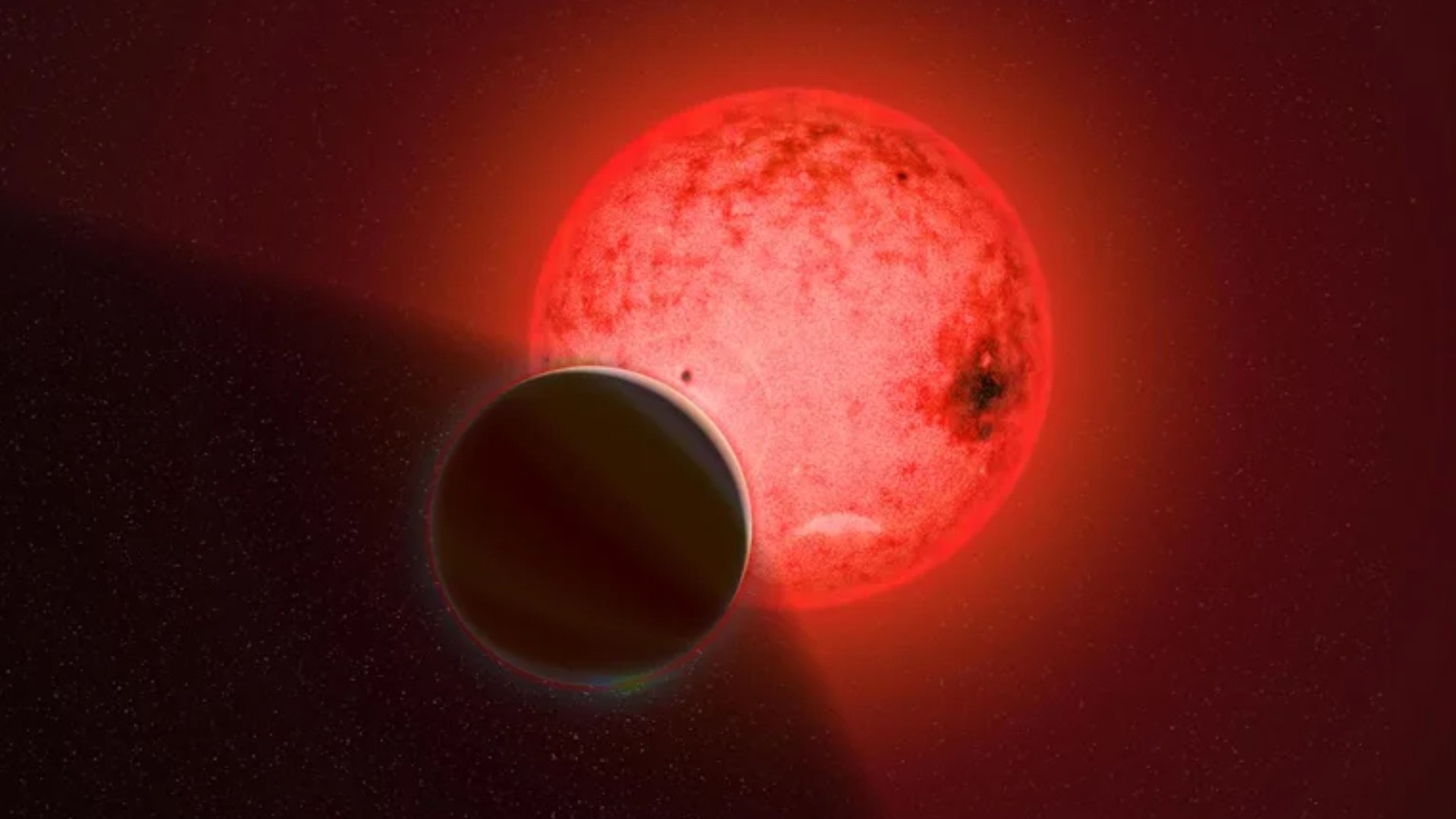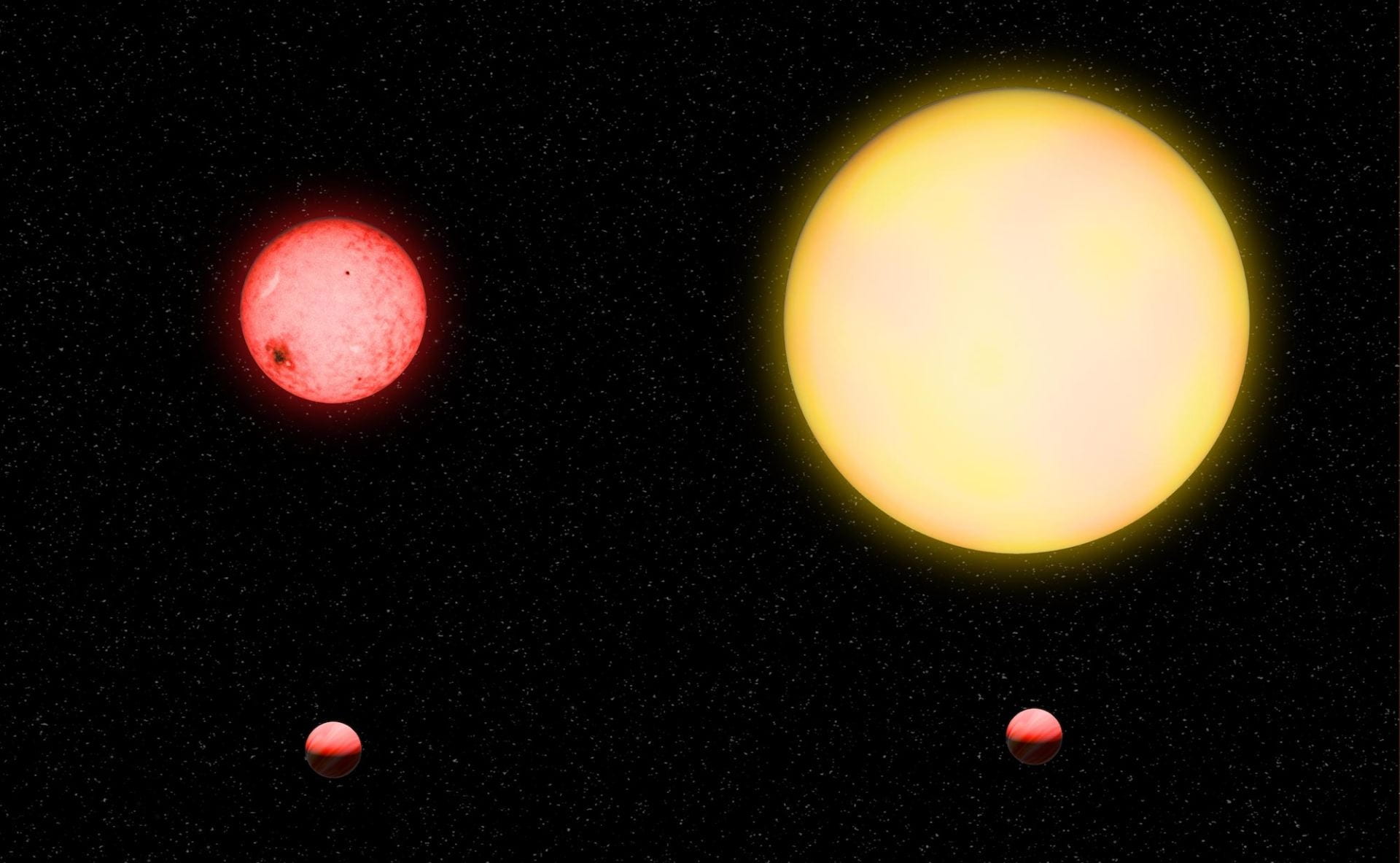Massive 'forbidden planet' orbits a strangely tiny star only 4 times its size
The discovery could challenge our theories of how gas giants like Jupiter form.

Astronomers have discovered an unusual planetary system consisting of a Jupiter-sized planet orbiting a tiny star that is only four times the size of the solar system gas giant. This "forbidden" configuration of a massive planet orbiting a relatively tiny star could challenge theories of how gas giant planets form.
The extrasolar planet, or "exoplanet," orbits a red dwarf star designated TOI 5205 that is much cooler and smaller than the sun. The small size and relatively cool temperatures of these M-dwarf stars, the most common type of stellar body in the Milky Way, make them redder than the sun.
Though on average this class of stars hosts more planets around them than other star types, it was previously believed that their formation makes them unlikely to be orbited by gas giants. The discovery of this exoplanet — designated TOI 5205b — by astronomers using NASA's Transiting Exoplanet Survey Satellite (TESS) telescope challenges that concept. The planet was confirmed and characterized by the team using various ground-based telescopes and instruments.
Related: Exoplanets: Worlds Beyond Our Solar System
"The host star, TOI-5205, is just about four times the size of Jupiter, yet it has somehow managed to form a Jupiter-sized planet, which is quite surprising!" team leader and Carnegie Science astronomer Shubham Kanodia said in a statement.
Though gas giants have been discovered around M dwarf stars before, none of them have been discovered orbiting such a low mass example of this class of star-like TOI-5205.
Planets are created in spinning discs of gas and dust called "protoplanetary discs" that surround young stars. This material is the remains of the same matter that collapsed to birth its central star. When dense patches collapse under their own gravity planet cores are born and they then collect more material.
Get the Space.com Newsletter
Breaking space news, the latest updates on rocket launches, skywatching events and more!
Current planet formation models suggest that to birth a gas giant it takes material equivalent to 10 times the mass of Earth. This first forms a rocky core and this core goes on to accumulate gas to form the disc to grow a giant planet. This process has to occur quickly, however.
"In the beginning, if there isn't enough rocky material in the disk to form the initial core, then one cannot form a gas giant planet. And at the end, if the disk evaporates away before the massive core is formed, then one cannot form a gas giant planet. And yet TOI-5205b formed despite these guardrails," Kanodia explained in the statement. "Based on our nominal current understanding of planet formation, TOI-5205b should not exist; it is a 'forbidden' planet."
To picture how unbalanced this system is to planetary systems that astronomers expect, imagine our star the sun squashed down to the size of a grapefruit. That size reduction would mean the largest gas giant in our solar system, Jupiter, would be about the size of a garden pea.
The TOI-5205 system is more like a pea orbiting a lemon.

The size disparity in the size is so great that when TESS used the drop in light caused by a planet as it passes in front of its star, known as the transit method, that dip in light was 7% of the star's total light output.
That makes the dimming of TOI-5205 by this Jupiter-sized exoplanet the largest known drop in light caused by an exoplanet transit.
This extreme dip in light or technically, "large transit depth," could make the system ideal for follow-up investigations with the James Webb Space Telescope (JWST).
Observations with the JWST could help determine the composition of TOI-5205 b's atmosphere and may shed light on the processes that birthed this "forbidden" planet.
The team's research is published in The Astronomical Journal.
Follow us on Twitter @Spacedotcom or on Facebook.
Join our Space Forums to keep talking space on the latest missions, night sky and more! And if you have a news tip, correction or comment, let us know at: community@space.com.

Robert Lea is a science journalist in the U.K. whose articles have been published in Physics World, New Scientist, Astronomy Magazine, All About Space, Newsweek and ZME Science. He also writes about science communication for Elsevier and the European Journal of Physics. Rob holds a bachelor of science degree in physics and astronomy from the U.K.’s Open University. Follow him on Twitter @sciencef1rst.
-
rod TOI 5205b, that is a good one here and very interesting. http://exoplanet.eu/catalog/toi-5205_b/ shows properties and it orbits very close to the red dwarf star.Reply
https://www.sciencedaily.com/releases/2023/02/230222141146.htm, "The host star, TOI-5205, is just about four times the size of Jupiter, yet it has somehow managed to form a Jupiter-sized planet, which is quite surprising!" exclaimed Kanodia, who specializes in studying these stars, which comprise nearly three-quarters of our galaxy yet can't be seen with the naked eye...The time frame in which this happens is crucial. "TOI-5205b's existence stretches what we know about the disks in which these planets are born," Kanodia explained. "In the beginning, if there isn't enough rocky material in the disk to form the initial core, then one cannot form a gas giant planet. And at the end, if the disk evaporates away before the massive core is formed, then one cannot form a gas giant planet. And yet TOI-5205b formed despite these guardrails. Based on our nominal current understanding of planet formation, TOI-5205b should not exist; it is a "forbidden" planet."
Forbidden planets could be a fun topic :)
ref - TOI-5205b: A Short-period Jovian Planet Transiting a Mid-M Dwarf, https://iopscience.iop.org/article/10.3847/1538-3881/acabce, 21-Feb-2023. “Abstract We present the discovery of TOI-5205b, a transiting Jovian planet orbiting a solar metallicity M4V star, which was discovered using Transiting Exoplanet Survey Satellite photometry and then confirmed using a combination of precise radial velocities, ground-based photometry, spectra, and speckle imaging. TOI-5205b has one of the highest mass ratios for M-dwarf planets, with a mass ratio of almost 0.3%, as it orbits a host star that is just 0.392 ± 0.015 M⊙. Its planetary radius is 1.03 ± 0.03 RJ, while the mass is 1.08 ± 0.06 MJ..." -
rod The total dust and gas for a postulated protoplanetary disc around a 0.392 solar mass red dwarf (MMSN model) could be 1.305136E+03 earth masses. The 1.08 Mjup exoplanet is about 3.432456E+02 earth masses.Reply
From the ref paper.
“6. Summary We present the discovery of TOI-5205b, a Jovian exoplanet orbiting a solar metallicity mid-M dwarf. TOI-5205b was first identified from TESS photometry, and then characterized using a combination of ground-based photometry, RVs, spectroscopic observations, and speckle imaging. The large mass ratio of the planet (∼0.3%) necessitates a disk that is ∼10% as massive as the host star, thereby stretching our current understanding of protoplanetary disks around M dwarfs. The typical scaling relations used to estimate disk properties are hard-pressed to reproduce the primordial disks that are massive enough to form such a planet. However there is significant scatter in disk dust mass measurements and scaling relations, which could still explain such massive planets around mid-M dwarfs. TOI-5205b has a large transit depth of 7%, which makes it an excellent candidate for transmission and emission spectroscopy, both from the ground (high-resolution) and space (JWST). Atmospheric characterization could help constrain the metallicity of the planet and could offer clues about their formation history. The large sample of M dwarfs being observed by TESS is already improving our understanding of planet formation around M dwarfs. While the first few discoveries were limited to the early-M dwarfs, we are now starting to find that it is indeed possible to form these gas giants around mid-M dwarfs. As we go from a sample of these planets around solar-type stars to mid-M dwarfs, there is a unique opportunity to study planet formation at its extremes, spanning more than a 2\00d7 range in stellar mass, and 100\00d7 in luminosity!” -
chris anderson Are we absolutely certain that it is a "rocky" gas giant? Why not a binary star that has failed to form because of a lack of total mass?Reply -
easy-ranger With the number of stars out there, even wildly improbably configurations are going to exist in abundance. Maybe this system only existed because of a sequence of unique gravitation interactions. Theories may be too rigid, but not entirely wrong. Also, we must take great care in exoplanet analysis because the data is skewed towards what is easiest to detect with our instruments, there is a lot of data we're missing because we can't detect it. Detecting this system is super easy because the planet has a massive effect on it's parent star. You can't not see it. An analog to our solar system at over 200ly might not be detectable with our current technology.Reply -
rod I can find 4 exoplanets like this, near or slightly larger than Jupiter mass found around very small mass stars.Reply
The star masses range 0.092 solar mass up to 0.392 solar mass (TOI-5205 b in this report). I used mass of exoplanet 0.9 to 1.1 Mjup to find them in my database (updated from exoplanet.eu site).
Their semi-major axis range 0.0199 au to 1.74 au.
TOI-5205 b, OGLE-2018-BLG-1647/KMT-2018-BLG-2060, OGLE-2018-BLG-1367/KMT'2018-BLG-0914, KMT-2018-BLG-1743 b
These exoplanets will have the same issues that TOI-5205 b does when it comes to origin. -
Dragrath Reply
This is a good question which as evidence for disk instability driven direct collapse as a dominant mode of large planetesimal formation grows both within our solar system and in young protoplanetary systems observed by long baseline interferometry the difference between planet and star is getting blurrier and harder to define. Now there is evidence that accretion is still significant i.e. it isn't either or but both since stellar metallicity has been found to correlate fairly strongly with the number and mass of planets given our limited sample sizes but it looks like large planetesimals form far more early on than traditionally assumed in more chaotic turbulent conditions. There is even evidence that stars can and do form this way around more massive parent stars or given the dominant planar alignment of many of the S stars around Sagittarius A* quite possibly generalized accretion itself as the coalescence of particulate grains in gas and dust serves as a means to allow the bulk accretionary flow to rapidly expel angular momentum.chris anderson said:Are we absolutely certain that it is a "rocky" gas giant? Why not a binary star that has failed to form because of a lack of total mass?
If memory serves were was even a recent paper which studied the radiation outflows of accreting protostars over time and found that contrary to expectations the flow seemed to occur in discrete bursts which energetically appear to be on average several Jupiter masses worth of material. Or in essence the collision of gaseous planetary masses may be the dominant mode of star formation i.e. stars may form from "planets" rapidly falling inwards due to gravitational interactions in the main coalescence stage with the planets left over being remnants of this process.
This may on a related note help resolve some of the apparent conundrums of super massive black hole growth as if the bulk accretionary flow is occurring in the disk around instability (plus subsequent accretion and collisions) derived compact objects.
After all many of those S stars appear to be young and very massive the sorts of stars which may undergo supernovae in a few million years with potentially more massive siblings that have already exploded. When accretion resumes what will happen to those compact objects left behind? might they not continue to grow until they become black holes which continue to in fall and collide into more and more massive compact bodies ultimately falling into the SMBH?
Lots of questions to investigate and mysteries to resolve out there.









